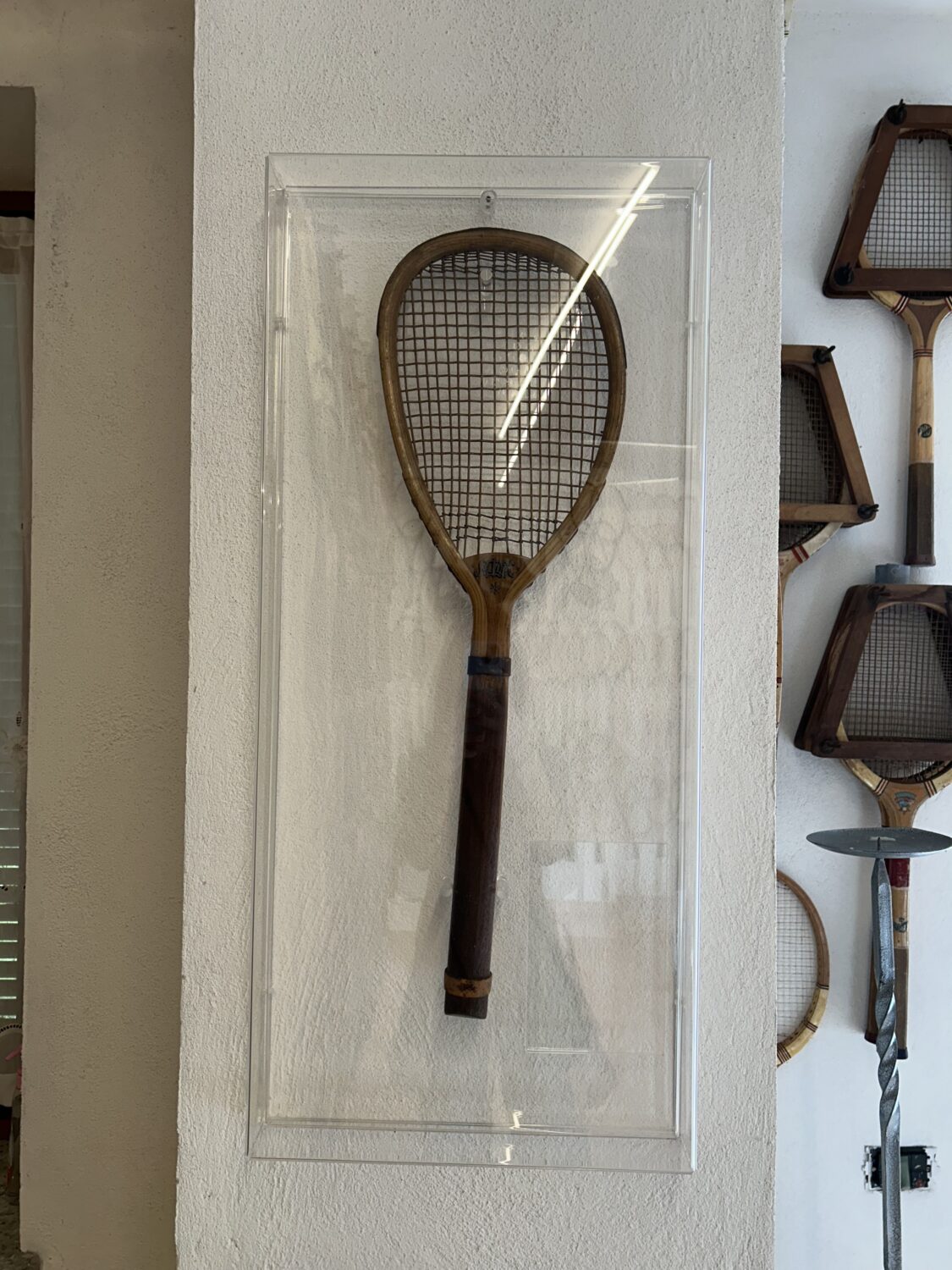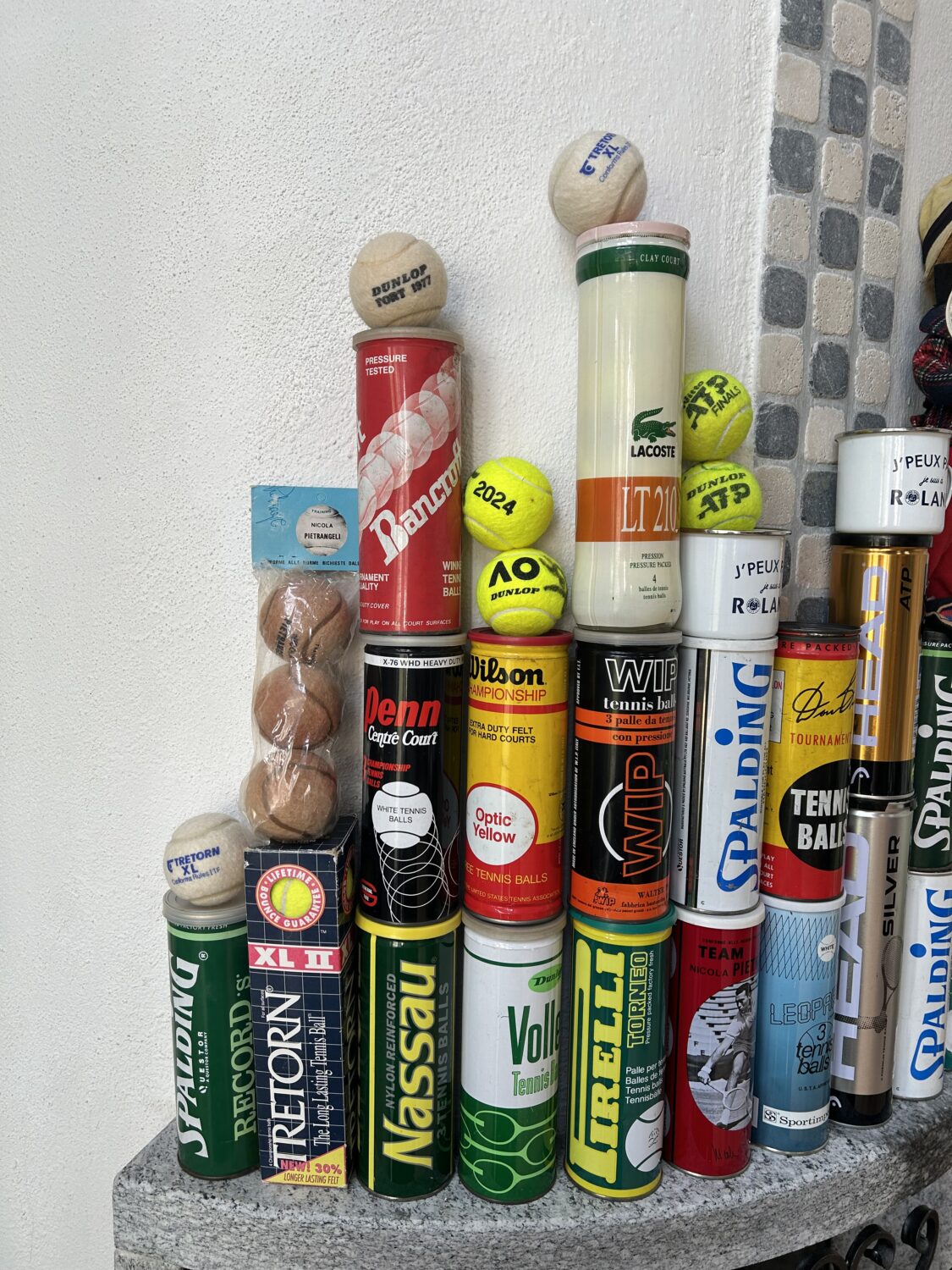The secret Racquet Museum in the north of Italy

When I arrive on the streets of Baldissero d’Alba, a town of 1060 inhabitants in the province of Cuneo, about an hour from the city of Turin, I’m convinced I’ve made a mistake. I check the address on the navigator, which however indicates that I have reached my destination. Beside me, I only see private houses with yellow walls, low roofs covered with brick-colored tiles, and old iron and copper gates. There’s no sign that could give me hope of being close to the Racquet Museum, no indication. I’ve already put the car in reverse when a tall, robust man with graying hair rushes toward me.
His name is Paolo Bertolino, by profession he’s a racket stringer and is the sole creator and owner of the museum I’m looking for. I follow him, and we enter a small garden with the car; at that moment, I understand that the museum is inside his house. He asks me to give him a minute, the time to open the door and turn on the lights. The truth dawns on me shortly after: “I always like to see people’s faces when they come in here for the first time“. And he’s right because, for a tennis enthusiast, and perhaps even for someone who has never held a racket in their life, the sight is quite astonishing. This is the only area of the house where the ceiling is about 10 meters high, and all around me in the room, there are only tennis rackets, photographs, posters, balls, bags, and historical tennis artifacts. Rackets cover the white walls, to my right there’s a staircase leading to the loft where the rackets are suspended in the air and seem endless.
I continue to look around, unsure where to start, but fortunately, Bertolino does: “It all started when I saw this“. He points to a photograph in a black frame, where I immediately recognize Borg and Connors on Wimbledon’s center court. “This photograph won a photography award in 1978, the golden athlete, Borg has just scored the match point when he throws the racket, which remains suspended in the air. After seeing this image, I started to think that one day I would like to put their rackets next to the photograph.” (photo1) Behind me, opposite that photograph, is the oldest piece in the museum. A racket from 1820, the bible of tennis, with which one played “Real Tennis” in castles and courts, bought on Porto Bello road (London).

“No tennis player knows how to make a tennis racket, a ball, or a string. But I do because to create this place, I studied everything” Bertolino tells me, pointing to everything tennis-related around us. 965 rackets divided by epochs, companies, and materials he has been able to collect mainly thanks to his work as a stringer for the members of the most important tennis club in the city of Turin: Circolo della Stampa Sporting. Many of his clients had kept historical artifacts in their cellars and garages for years, now unfindable: “That’s why I thought, I want to build something different, where others cannot reach,” Bertolino explains, “The rackets don’t have to be many, the important thing is that they are perfect, and I dedicate myself every day to maintaining them. Many wives of the club members have come to thank me for finally emptying their cellars.”
We continue the dive into the past that we started by talking about one of the most famous rackets in Italian tennis history: the “Maxima” racket. (photo 3) In 1918, the Billour brothers’ furniture factory in Bordighera converted to the production of rackets for the English (about 3,000) residing on the Riviera and members of the Bordighera Lawn Tennis & Croquet Club, the oldest club in Italy created in 1878, four years after the major Wingfield patented the new game of tennis. In 1920 the Billour only produced rackets under the name of S.I.R.T (Italian Tennis Racket Company), also exported to England for their excellent quality. In 1926, two good tennis players, Pier Giovanni Pietra (Italian) and George Prouse (New Zealander), became representatives of Dunlop after completing their studies, an English brand that produced rackets and tennis balls. They founded “Davis”: Dunlop Agency Italy Sports Sales to import Dunlop products from England. On October 11, 1935, the League of Nations established an embargo that no longer allowed commercial exchanges between Italy and England. So Pietra and Prouse found themselves with the opposite problem of the Billour. The two players could no longer import Dunlop English products and the Billour brothers could no longer sell their Sirt in England. From this situation, the Maxima brand was born, produced by Sirt. “For almost half a century, the Maxima Tournament was the best-selling racket in our country and adopted by all the great Italian champions. In 1978, Maxima sold 200,000 rackets, of which 90,000 were ‘Maxima Tournament’,” Bertolino tells me, carefully showing me the racket we are talking about.

We approach the wall dedicated to the famous “Lacoste” brand where he finds what he calls: the most winning racket in the history of tennis to date. “René Lacoste was an engineer with a brilliant mind” says Bertolino, taking in his hands what looks like a precious jewel. “Lacoste created the first ball machine, then patented by Dunlop and became one of the strongest tennis players of his time (1906-1996). He wasn’t as good athletically, but he was ahead of everyone mentally.” The Lacoste crocodile symbol was born precisely because of tennis. René was in Boston with the Davis Cup team when he and the captain, Pierre Gillou, passed by a boutique the day before the match and saw that crocodile-shaped bag. So they made a bet: Gillou told Lacoste that if he won the next day’s singles, he would give him the crocodile-shaped bag. From the day René Lacoste won the matches and the bag, he became: Mister Crocodile. From that nickname, he also launched one of the most famous sports lines in the world with the crocodile strictly facing left. Later, Lacoste realized that wooden rackets would have a short life. Wood tended to warp too much, so he decided to patent a system called “Suspension Stringing” and put a synthetic element in place of the wood, held together by a crown fixed to a wire. “See, now the string doesn’t touch the frame anymore” Bertolino shows me. (photo 4) In 1962, the racket was sold with the rights to Wilson, and over the years, it won 109 tournaments. Certainly fewer than today, but still a record.
As Bertolino puts the most winning racket in history back in its place, I get lost in the wonderful wall dedicated to the “Big Three.” (photo 5) Roger Federer’s photograph is twice as large as that of Rafael Nadal and Novak Djokovic, and Bertolino doesn’t hide his preference: “For me, Federer is something beyond tennis.” Around their portraits are the rackets with which they have won the most, and each of them is a piece of their history. Next to that wall, there is an identical one with Rod Laver, Pete Sampras, and Andre Agassi, and even there, I notice that Pete Sampras’s photo is significantly more prominent.

Finally, we go upstairs where an installation of dozens and dozens of rackets suspended in the air awaits us. There’s a piece of furniture on which I notice tennis balls never seen before. There are the white Pirelli 1961 balls made in Italy, or those of the Regent Don Budge made in England, the brown ones of Nicola Pietrangeli. (balls photo)
In front of the piece of furniture is the racket installation dedicated to the “Prince” brand (prince photo) and the one dedicated to the “Wilson” brand. As we descend the stairs to go back downstairs, I notice that everything in that room speaks of tennis: books, furniture, posters, ashtrays, bags, even the chairs. On top of a wooden chest, I see another historical artifact never seen before. “This is a racket holder from 1910, where a maximum of three rackets could be inserted. Tennis bags didn’t exist back then“, Bertolino explains to me as he shows it to me. Then I point out the mysterious box above the same chest. He opens it immediately: “This, on the other hand, is a Puma racket, and it’s Boris Becker’s original. The only player who managed to win a Slam with both white balls and yellow balls.”

According to Bertolino, there’s still a racket that deserves my special attention. It’s the most unique Italian racket ever built by Pirelli in collaboration with the famous designer Nuccio Bertone. A very daring project that was sold in a briefcase because of the detachable racket, made up of three separate elements: the string bed, the handle, and the frame. A racket with which perhaps no one has ever played: the Pirelli Technort B1, put on sale in the early 90s for 600 euros. (photo 8) As Bertolino opens the door connecting his house to the museum to go make coffee, I wander through that small and fascinating museum with one question: what is the main objective of that place to which he has dedicated so much effort and passion: “I would like all enthusiasts, young and old, to come here to discover something they don’t yet know about this incredible sport. I would like to explain to them where it was born, how it evolved, and how much history there is behind a game. And then, now I know what will become of my retirement.“
Regarding the size of Federer’s photo on the wall. I ask him if he wouldn’t like to have something original of the Swiss player as well. He smiles: “That’s another story“. And I understand that perhaps, something original is already inside there.
